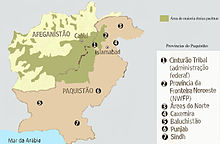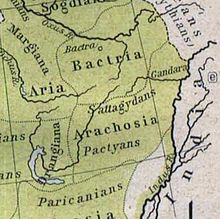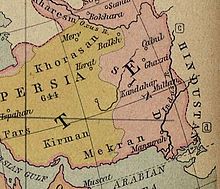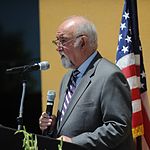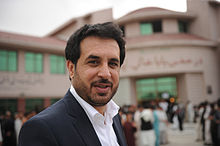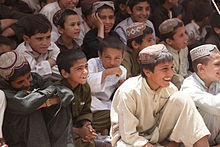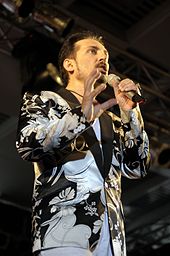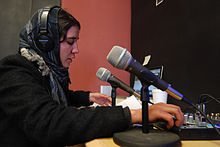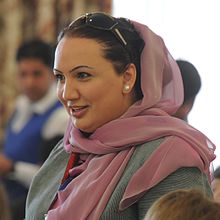- Pashtun people
-
Pashtuns
پښتانه
Paṣ̌tun1st row: Ibrahim Lodi · Sher Shah · Rahman Baba
2nd row: Khushal Khan · Mirwais · Ahmad Shah
3rd row: Akbar Khan · Ayub Khan · Abdur Rahman
4th row: Amanullah · Bacha Khan · Zahir Shah
5th row: Momand · Khalilzad · Hamid KarzaiTotal population Approx. 50 million (2009)[1] Regions with significant populations  Pakistan
Pakistan27.2 million (2009) [2]  Afghanistan
Afghanistan13.46 million (2010) [3]  UAE
UAE338,315 (2009) [4]  Iran
Iran110,000 (2010) [5]  United Kingdom
United Kingdom100,000 (2009) [6]  Canada
Canada26,000 (2006) [7]  India
India11,086 (2001) [8]  United States
United States7,710 (2000) [9]  Malaysia and
Malaysia and  Singapore
Singapore5,100 (2008) [10] Languages Pashto
Urdu and Dari spoken as second languagesReligion Related ethnic groups Tajiks · Baloch · Hindkowans · Pashai · Nuristanis · Burusho
Pashtuns (Pashto: پښتانه paṣtāná, Pax̌tun, also rendered as Pushtuns, Pakhtuns, Pukhtuns) or Pathans (Urdu: پٹھان Paṭhān), also known as ethnic Afghans (Persian: افغان), are an Eastern Iranic ethnic group with populations primarily between the Hindu Kush mountains in Afghanistan and the Indus River in Pakistan.[11] The Pashtuns are typically characterised by their usage of the Pashto language and practice of Pashtunwali, which is a traditional set of ethics guiding individual and communal conduct. Their origins are unclear but historians have come across references to various ancient peoples called Paktha (Pactyans) between the 2nd and the 1st millennium BC,[12][13][14] who may be the early ancestors of Pashtuns. Since the 3rd century AD and onward, they are mostly referred to by the ethnonym "Afghan".[15][16][17][18]
Often characterised as a warrior and martial race, they have a tumultuous past, especially after their conversion to the faith of Islam. Their turbulent history is spread amongst various countries of South, Central and West Asia, centred around the medieval state of Afghanistan, which has been their traditional seat of power. During the Delhi Sultanate era, many Pashtun emperors (sultans) ruled the Indian subcontinent. Other Pashtuns defeated the Safavid Persians and the Mughal Empire[19] before obtaining an independent state in the early-18th century, which began with a successful revolution by the Hotaki dynasty followed by conquests by Ahmad Shah Durrani.[20] Pashtuns played a vital role during the Great Game from the 19th century to the 20th century as they were caught between the imperialist designs of the British and Russian empires. Pashtuns are the largest ethnic group in Afghanistan; for over 300 years, they have reigned as the dominant ethno-linguistic group, with nearly all rulers being Pashtun. More recently, the Pashtuns gained global attention during the 1980s Soviet war in Afghanistan and with the rise of the Taliban, since they are the main ethnic contingent in the movement. Pashtuns are also an important community in Pakistan, which has the largest Pashtun population and where they constitute the second-largest ethnic group, having attained presidency and high positions in the armed forces.
The Pashtuns are the world's largest (patriarchal) segmentary lineage ethnic group. According to Ethnologue, the total population of the group is estimated to be around 50 million[1] but an accurate count remains elusive due to the lack of an official census in Afghanistan since 1979. Estimates of the number of Pashtun tribes and clans range from about 350 to over 400.[19][21]
Contents
Geographic distribution
The vast majority of Pashtuns are found in the traditional Pashtun homeland, stretching between the Hindu Kush mountains in Afghanistan and west of the Indus River in Pakistan, which includes Khyber-Pakhtunkhwa, Federally Administered Tribal Areas (FATA) and part of Balochistan. Additional Pashtun communities are located in western and northern Afghanistan, the Gilgit-Baltistan and Kashmir regions and northern Punjab province of Pakistan, as well as in the Khorasan province of Iran. There are also sizeable Muslim communities in India, which are of largely putative Pashtun ancestry.[8][22] Throughout the Indian subcontinent, excluding Pashtun-dominated regions, they are often referred to as Pathans. Smaller Pashtun communities are found in the countries of the Arabian Peninsula, Europe and the Americas, particularly in North America.
Important metropolitan centres of Pashtun culture include Kandahar, Quetta, Peshawar, Jalalabad, Kunduz and Swat. Kabul and Ghazni are home to around 25% Pashtun population while Herat and Mazar-i-Sharif each has at least 10%.[23] With as high as 7 million by some estimates, the city of Karachi in Pakistan may have the largest concentration of urban Pashtuns in the world.[24][25] In addition, Rawalpindi, Islamabad, and Lahore also have sizeable Pashtun populations.[26]
Pashtuns comprise roughly 15.4% of Pakistan's 174 million population.[2] In Afghanistan, they make up an estimated 42% of the 29 million population according to the CIA World Factbook.[27] Some sources give 50–60%[28][29][30][31][32][33] because the exact figure remains uncertain in Afghanistan, and are affected by the 1.7 million Afghan refugees that remain in Pakistan a majority of which are Pashtuns.[34] Another 937,600 Afghans live in Iran according to the United Nations High Commissioner for Refugees (UNHCR).[35] A cumulative population assessment suggests a total of around 49 million individuals all across the world.[1]
Further information: Pashtuns in Bihar, Pathans of Gujarat, Pathans of Punjab, Pathans of Rajasthan, and Pathans of Uttar PradeshHistory and origins
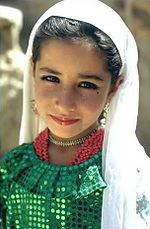
Part of a series on
PashtunsKingdoms (Lodi · Suri
Hotaki · Durrani)
Afghanistan · Pakistan
Pashtunistan · Pakhtunkhwa
Pashtunization
The history of the Pashtun people is ancient and much of it is not fully researched. Since the 2nd millennium BC, cities in the region now inhabited by Pashtuns have seen invasions and migrations, including by Ancient Iranian peoples, the Median and Persian empires of antiquity, Greeks, Mauryas, Kushans, Hephthalites, Sassanids, Arab Muslims, Turks, Mongols, Palas and others. In recent age, people of the Western world have explored the area as well.[36][37][38][39]
There are many conflicting theories about the origin of Pashtuns, some modern and others archaic, both among historians and the Pashtuns themselves. According to most historians and experts, the true origin of the Pashtuns is some what unclear.[40]
...the origin of the Afghans is so obscure, that no one, even among the oldest and most clever of the tribe, can give satisfactory information on this point.[41]Looking for the origin of Pashtuns and the Afghans is something like exploring the source of the Amazon. Is there one specific beginning? And are the Pashtuns originally identical with the Afghans? Although the Pashtuns nowadays constitute a clear ethnic group with their own language and culture, there is no evidence whatsoever that all modern Pashtuns share the same ethnic origin. In fact it is highly unlikely.[42]Ancient references
A variety of ancient groups with eponyms similar to Pukhtun have been hypothesized as possible ancestors of modern Pashtuns. The Rigveda (1700–1100 BC) mentions a tribe called Paktha inhabiting eastern Afghanistan and academics have proposed their connection with today's Pakhtun people.[12][13] Furthermore, the Greek historian Herodotus mentioned a people called Pactyans living in the same area (Achaemenid's Arachosia Satrapy) as early as the 1st millennium BCE.[14] It is believed that these may have been the ancient ancestors of Pashtuns.[12]
Some modern-day Pashtun tribes have also been identified living in ancient Gandhara (i.e. Alexander's historians mentioned "Aspasii" in 330 BC and that may refer to today's Afridis).[43] Herodotus has mentioned the same Afridi tribe as "Apridai" over a century earlier.[44] Strabo, who lived between 64 BC and 24 CE, explains that the tribes inhabiting the lands west of the Indus River were part of Ariana and to their east was India.[12]
In the Middle Ages until the advent of modern Afghanistan in the 18th century and the division of Pashtun territory by the 1893 Durand Line, Pashtuns were often referred to as ethnic "Afghans". The earliest mention of the name Afghan (Abgân) is by Shapur I of the Sassanid Empire during the 3rd century CE,[15][16][45] which is later recorded in the 6th century CE in the form of "Avagānā" by the Indian astronomer Varāha Mihira in his Brihat-samhita.[17] It was used to refer to a common legendary ancestor known as "Afghana", propagated to be grandson of King Saul of Israel.[40][46][47] Hiven Tsiang, a Chinese pilgrim, visiting the Afghanistan area several times between 630 to 644 CE also speaks about them.[15][48] In Shahnameh 1–110 and 1–116, it is written as Awgaan.[15] Ancestors of many of today's Turkic-speaking Afghans settled in the Hindu Kush area and began to assimilate much of the culture and language of the Pashtun tribes already present there.[49] Among these were the Khalaj people which are known today as Ghilzai.[50] According to several scholars such as V. Minorsky, the name "Afghan" is documented several times in the 982 CE Hudud-al-Alam.[45]
—Hudud ul-'alam, 982 CEThe village of Saul was probably located near Gardez, Afghanistan. Hudud ul-'alam also speaks of a king in Ninhar (Nangarhar), who had Muslim, Afghan and Hindu wives.[42] Al-Biruni wrote about Afghans in the 11th century as various tribes living in the western mountains of India and extending to the region of Sind, which would be the Sulaiman Mountains area between Khorasan and Hindustan. It was reported that between 1039 and 1040 CE Mas'ud I of the Ghaznavid Empire sent his son to subdue a group of rebel Afghans near Ghazni. An army of Arabs, Afghans, Khiljis and others was assembled by Arslan Shah Ghaznavid in 1119 CE. Another army of Afghans and Khiljis was assembled by Bahram Shah Ghaznavid in 1153 CE. Muhammad of Ghor, ruler of the Ghorids, also had Afghans in his army along with others.[51] A famous Moroccan travelling scholar, Ibn Battuta, visiting Afghanistan following the era of the Khilji dynasty in early 1300s gives his description of the Afghans.
We travelled on to Kabul, formerly a vast town, the site of which is now occupied by a village inhabited by a tribe of Persians called Afghans. They hold mountains and defiles and possess considerable strength, and are mostly highwaymen. Their principle mountain is called Kuh Sulayman. It is told that the prophet Sulayman [Solomon] ascended this mountain and having looked out over India, which was then covered with darkness, returned without entering it.[52]—Ibn Battuta, 1333Muhammad Qasim Hindu Shah (Ferishta), writes about Afghans and their country called Afghanistan in the 16th century.
The men of Kábul and Khilj also went home; and whenever they were questioned about the Musulmáns of the Kohistán (the mountains), and how matters stood there, they said, "Don't call it Kohistán, but Afghánistán; for there is nothing there but Afgháns and disturbances." Thus it is clear that for this reason the people of the country call their home in their own language Afghánistán, and themselves Afgháns. The people of India call them Patán; but the reason for this is not known. But it occurs to me, that when, under the rule of Muhammadan sovereigns, Musulmáns first came to the city of Patná, and dwelt there, the people of India (for that reason) called them Patáns—but God knows![53]One historical account connects the Pakhtuns of Pakistan to a possible Ancient Egyptian past but this lacks supporting evidence.
I have read in the Mutla-ul-Anwar, a work written by a respectable author, and which I procured at Burhanpur, a town of Khandesh in the Deccan, that the Afghans are Copts of the race of the Pharaohs; and that when the prophet Moses got the better of that infidel who was overwhelmed in the Red Sea, many of the Copts became converts to the Jewish faith; but others, stubborn and self-willed, refusing to embrace the true faith, leaving their country, came to India, and eventually settled in the Sulimany mountains, where they bore the name of Afghans.[18]—Ferishta, 1560–1620Additionally, although this too is unsubstantiated, some Afghan historians have maintained that Pashtuns are linked to the ancient Israelites.
The Afghan historians proceed to relate that the children of Israel, both in Ghore and in Arabia, preserved their knowledge of the unity of God and the purity of their religious belief, and that on the appearance of the last and greatest of the prophets (Mohammed) the Afghans of Ghore listened to the invitation of their Arabian brethren, the chief of whom was Khauled (or Caled), son of Waleed, so famous for his conquest of Syria, and marched to the aid of the true faith, under the command of Kyse, afterwards surnamed Abdoolresheed.[54]—Mohan Lal, 1846Anthropology and oral traditions
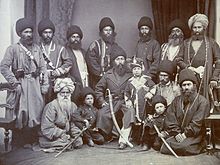 Earliest Pashtun photograph in which Amir Sher Ali Khan is sitting with Prince Abdullah Jan and the Afghan Sardars in 1869.
Earliest Pashtun photograph in which Amir Sher Ali Khan is sitting with Prince Abdullah Jan and the Afghan Sardars in 1869.
Some anthropologists lend credence to the oral traditions of the Pashtun tribes themselves. For example, according to the Encyclopaedia of Islam, the theory of Pashtun descent from Israelites is traced to Maghzan-e-Afghani who compiled a history for Khan-e-Jehan Lodhi in the reign of Mughal Emperor Jehangir in the 17th century.[44]
Another book that corresponds with Pashtun historical records, Taaqati-Nasiri, states that in the 7th century BC a people called the Bani Israel settled in the Ghor region of Afghanistan and migrated later to the southeast areas. These references to Bani Israel agree with the commonly held view by Pashtuns that when the twelve tribes of Israel were dispersed (see Israel and Judah and Ten Lost Tribes), the tribe of Joseph, among other Hebrew tribes, settled in the region.[55] This oral tradition is widespread among the Pashtuns. There have been many legends over the centuries of descent from the Ten Lost Tribes after groups converted to Christianity and Islam. Hence the tribal name Yusufzai in Pashto translates to the "son of Joseph". A similar story is told by the 16th century Persian historian, Ferishta.[18]
One conflicting issue in the belief that the Pashtuns descend from the Israelites is that the Ten Lost Tribes were exiled by the ruler of Assyria, while Maghzan-e-Afghani says they were permitted by the ruler to go east to Afghanistan. This inconsistency can be explained by the fact that Persia acquired the lands of the ancient Assyrian Empire when it conquered the Empire of the Medes and Chaldean Babylonia, which had conquered Assyria decades earlier. But no ancient author mentions such a transfer of Israelites further east, or no ancient extra-Biblical texts refer to the Ten Lost Tribes at all.
Other Pashtun tribes claim descent from Arabs, including some even claiming to be descendants of the Islamic prophet Muhammad (referred to as Sayyids).[56] Some groups from Peshawar and Kandahar claim to be descended from Ancient Greeks that arrived with Alexander the Great.[57]
In terms of race, the Pashtuns are classified as Caucasians[46] of the Mediterranean variant.[58] Their Pashto language is classified under the Eastern Iranian sub-branch of the Iranian branch of the Indo-European family of languages.[59]
Early precursors to the Pashtuns were old Iranian tribes that spread throughout the eastern Iranian plateau.[60] According to the Russian scholar Yu. V. Gankovsky, the Pashtuns probably began as a "union of largely East-Iranian tribes which became the initial ethnic stratum of the Pashtun ethnogenesis, dates from the middle of the first millennium CE and is connected with the dissolution of the Epthalite (White Huns) confederacy." He proposes Kushan-o-Ephthalite origin for Pashtuns.[61][62]
Those who speak a dialect of Pashto in the Kandahar region refer to themselves as Pashtuns, while those who speak a Peshawari dialect call themselves Pukhtuns. These native people compose the core of ethnic Pashtuns who are found in southeastern Afghanistan and western Pakistan. The Pashtuns have oral and written accounts of their family tree. The elders transfer the knowledge to the younger generation. Lineage is considered very important and is a vital consideration in marital business.
Genetics
Research into human DNA is a new way to explore historical movements of populations by studying their genetic make-up.
Various Genetic studies have been carried out by different sources. The latest studies indicate a multi match for certain haplotypes that include in particular haplogroups J2, G1, G2c and subtypes.
The Gs include G1, G2c (Y-STR haplotype 731),2,3,5 from various studies:
- Table 3 in the study by Sengupta et al. (2006) Pakistani (n=176), Y chromosome lineages.[63] ncbi.nlm.nih.gov
- Firasat et al. and Sengupta et al. (2006)[64]
- The YHRD European forensic database has several haplotypes from Pakistan that are very likely to be G2c[65][66]
Population and
Locationn Status DYS393 DYS390 DYS19 DYS391 DYS385 DYS426 DYS388 DYS439 DYS392 DYS389 DYS438 DYS461
= add 2 to DYSA7.2Ashkenazi Jews
Poland-Lithuania
Western Germany Sicilians300 confirmed 12
13
22
23
24
15
169
10
1113,15
13,16
14,1611 12
11
1211 13,30
13,31
13,32
13,33
14,31
14,32
14,33
15,3310 12 Pathans 1 confirmed 13 23 16 11 13,16 11 12 11 11 13,30 Pathans 6 confirmed 13 23 17 10 11 12 11 11 13,30 Some genetic genealogy studies also indicate a minor contribution to the Pashtun DNA from Iranian, Arab, Turkish and Greek peoples.[67]
The theory of Pashtun descent from Israelites is currently being studied by Navras Aafreedi and Shahnaz Ali of India.[68][69]
"Pathans, or Pashtuns, are the only people in the world whose probable descent from the lost tribes of Israel finds mention in a number of texts from the 10th century to the present day, written by Jewish, Christian and Muslim scholars alike, both religious as well as secularists."[70]Israel is planning to fund this rare genetic study to determine whether there is a link between the lost tribes of Israel and the Pashtuns.
"Of all the groups, there is more convincing evidence about the Pashtuns than anybody else, but the Pashtuns are the ones who would reject Israel most ferociously. That is the sweet irony."[70]Mitochondrial DNA analysis on a 2500 year-old skeleton excavated from a Scythian kurgan at the Kizil site in the Altai Republic casts doubt on the theory of Pashtun descent from Scythians. Results showed the remains to be a member of haplogroup N1a.[71] This haplogroup is spread widely across Eurasia and northeast Africa in low frequencies but is not currently identified in Pashtuns. Precise matches to the Scythian skeleton are found in Yemen, Armenia, Egypt, Germany, and Estonia. Additionally:
- Mitochondrial DNA extracted from two Scytho-Siberian skeletons (Altai Republic (Russia) dating back 2,500 years) show characteristics "of mixed Euro-Mongoloid origin". ("European" in this context means Western Eurasian).[72] One of the individuals was found to carry the F2a maternal lineage, and the other the D lineage, both of which are characteristic of East Eurasian populations.[73]
- Maternal genetic analysis (of Saka period male and female skeletal remains, Beral site Kazakhstan) determined an HV1 mitochondrial sequence in the male (most frequent in European populations) and the HV1 sequence of the female to be of an Asian origin. It was suggested that the female may have derived from either mtDNA X or D.[74]
- Y-Chromosome DNA testing (ancient Scythian skeletons dated to the 5th century BCE, Sebÿstei site) exhibited the R1a1 haplogroup. A search in the YHRD database as well as the researching scientists' own database revealed close matches were found for a haplotype found at high frequency in Altaians & among eastern Europeans and Central Anatolia. Other haplotype matches closely matched types in Poland, Germany, Anatolia, Armenia, Nepal and India.[75]
Modern era
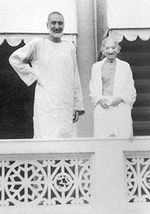 Leader of the non-violent Khudai Khidmatgar, also referred to as "the Red shirts" movement, Bacha Khan, standing with Mohandas Gandhi.
Leader of the non-violent Khudai Khidmatgar, also referred to as "the Red shirts" movement, Bacha Khan, standing with Mohandas Gandhi.
The Pashtuns are intimately tied to the history of modern Afghanistan, Pakistan and northern India. Following Muslim conquests from the 7th to 10th centuries, Pashtun ghazis (warriors) invaded and conquered much of the Indian subcontinent during the Ghaznavids (963–1187), Ghurid dynasty (1148–1215), Khilji dynasty (1290–1321), Lodhi dynasty (1451–1526) and Suri dynasty (1540–1556). Their modern past stretches back to the Hotaki dynasty (1709–1738) and the Durrani Empire. The Hotakis were Ghilzai tribesmen, who defeated the Persian Safavids and seized control over much of Persia from 1722 to 1738.[76] This was followed by the conquests of Ahmad Shah Durrani who was a former high-ranking military commander under Nader Shah of Khorasan. He created the last Afghan empire that covered most of what is today Afghanistan, Pakistan, Kashmir, Indian Punjab, as well as the Kohistan and Khorasan provinces of Iran.[20] After the decline of the Durrani dynasty in the first half of the 19th century under Shuja Shah Durrani, the Barakzai dynasty took control of the empire. Specifically, the Mohamedzai subclan held Afghanistan's monarchy from around 1826 to the end of Zahir Shah's reign in 1973. This legacy continues into modern times as the state is led by the Karzai administration under President Hamid Karzai, who is from the Popalzai tribe of Kandahar.
 Afghan President Hamid Karzai and Abdul Rahim Wardak, the Defense Minister of Afghanistan since 2004.
Afghan President Hamid Karzai and Abdul Rahim Wardak, the Defense Minister of Afghanistan since 2004.
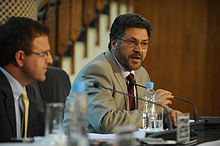 Afghan Finance Minister Omar Zakhilwal and Education Minister Ghulam Farooq Wardak during a joint US-Afghan letter signing in 2011.
Afghan Finance Minister Omar Zakhilwal and Education Minister Ghulam Farooq Wardak during a joint US-Afghan letter signing in 2011.
The Pashtuns in Afghanistan resisted British designs upon their territory and kept the Russians at bay during the so-called Great Game. By playing the two super powers against each other, Afghanistan remained an independent sovereign state and maintained some autonomy (see the Siege of Malakand). But during the reign of Abdur Rahman Khan (1880–1901), Pashtun regions were politically divided by the Durand Line, and what is today western Pakistan was claimed by British in 1893. In the 20th century, many politically-active Pashtun leaders living under British rule of undivided India supported Indian independence, including Ashfaqulla Khan,[77] Abdul Samad Khan Achakzai, Ajmal Khattak, Bacha Khan and his son Wali Khan (both members of the Khudai Khidmatgar, popularly referred to as the Surkh posh or "the Red shirts"), and were inspired by Mohandas Gandhi's non-violent method of resistance.[78][79] Some Pashtuns also worked in the Muslim League to fight for an independent Pakistan, including Yusuf Khattak and Abdur Rab Nishtar who was a close associate of Muhammad Ali Jinnah.[80][81]
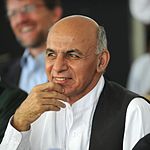 Dr. Ashraf Ghani Ahmadzai, former member of World Bank, Finance Minister of Afghanistan and chancellor of Kabul University.
Dr. Ashraf Ghani Ahmadzai, former member of World Bank, Finance Minister of Afghanistan and chancellor of Kabul University.
The Pashtuns of Afghanistan attained complete independence from British intervention during the reign of King Amanullah Khan, following the Third Anglo-Afghan War. The Afghan monarchy ended when President Daoud Khan seized control of Afghanistan from his cousin King Zahir Shah in 1973. This opened the door to Soviet intervention and the rise of Afghan Marxists, who assassinated Daoud Khan along with his family and relatives in the 1978 Marxist revolution. After this, many Pashtuns began joining the mujahideen opposition against the 1979 Soviet invasion of Afghanistan. This included famous figures such as Mullah Omar, Gulbuddin Hekmatyar and Jalaluddin Haqqani, who are currently waging a jihad against the US-led NATO forces and the Islamic republic of Afghanistan. In the meantime, millions of them began fleeing their native land to live among other Afghan diaspora in neighbouring Pakistan and Iran, while thousands of them proceeded to North America, the European Union, the Middle East, Australia and other parts of the world.
In the late 1990s, they became known for being the primary ethnic group that comprised the Taliban, which was a religious government based on Islamic sharia law formed to end the civil war.[82] On the other hand, the Taliban opposition also included Pashtuns. Among them were Abdul Qadir and his brother Abdul Haq, Abdul Rasul Sayyaf, Gul Agha Sherzai, the Karzais, Abdullah Abdullah, Asadullah Khalid and many others. The Taliban were ousted in late 2001 during the US-led Operation Enduring Freedom and replaced with the current Karzai administration, which is dominated by Pashtun ministers.[83] Some of these include: Foreign Minister Zalmay Rasoul, Defense Minister Abdul Rahim Wardak, Finance Minister Omar Zakhilwal, Education Minister Ghulam Farooq Wardak, Commerce Minister Anwar ul-Haq Ahady, Agriculture Minister Mohammad Asef Rahimi and Communication Minister Amirzai Sangin. The list of current governors of Afghanistan, as well as the parliamentarians in the House of the People and House of Elders, include large percentage of Pashtuns. The Chief of staff of the Afghan National Army, Sher Mohammad Karimi, and Commander of the Afghan Air Force, Mohammad Dawran, as well as Chief Justice of Afghanistan Abdul Salam Azimi and Attorney General Mohammad Ishaq Aloko also belong to the Pashtun ethnic group. Several prominent Pashtun families include the Tarzis, Gilanis, and the Karzais.
They not only played an important role in South Asia but also in Central Asia, including the Middle East. The Afghan royal family, which was represented by king Zahir Shah, is of ethnic Pashtun origin. Other prominent Pashtuns include the 17th-century poets Khushal Khan Khattak and Rahman Baba, and in contemporary era Afghan Astronaut Abdul Ahad Mohmand, former U.S. Ambassador to the United Nations Zalmay Khalilzad, Ashraf Ghani Ahmadzai, Ali Ahmad Jalali, Hedayat Amin Arsala and Mirwais Ahmadzai among many others.
Ethnic Pashtuns of Pakistan, notably Ayub Khan, Yahya Khan and Ghulam Ishaq Khan, attained the Presidency. Ghulam Mohammad became the Governor-General of Pakistan from 1951 to 1955. Many more held high government posts, such as Army Chief Gul Hassan Khan, Abdul Waheed Kakar, Interior Minister Aftab Ahmad Sherpao, and so on. Others became famous in sports (i.e. Shahid Afridi, Imran Khan, Jahangir Khan, and Jansher Khan) and literature (i.e. Ghani Khan, Ameer Hamza Shinwari, Munir Niazi, and Omer Tarin). The Awami National Party (ANP) of Pakistan is represented by Pashtun nationalist Asfandyar Wali Khan, grandson of Bacha Khan, while the chairman of the Pakhtunkhwa Milli Awami Party (PMAP) is Mahmood Khan Achakzai, son of Abdul Samad Khan Achakzai.
One of India's former presidents, Zakir Hussain, had Pashtun origin of the Afridi tribe who came from an upper middle class Pashtun family settled in Farrukhabad.[84][85][86] Mohammad Yunus, India's former ambassador to Algeria and advisor to Indira Gandhi, is an ethnic Pashtun related to the legendary Bacha Khan.[87][88][89][90]
Pashtuns defined
Among historians, anthropologists, and the Pashtuns themselves, there is some debate as to who exactly qualifies as a Pashtun. The most prominent views are:
- Pashtuns are predominantly an Eastern Iranian people, speakers of the Pashto language, and live in a contiguous geographic location across Afghanistan and Pakistan. This is the generally accepted academic view.[91]
- They are Sunni Muslims, follow Pashtunwali and meet other criteria.[46][91]
- In accordance with the legend of Qais Abdur Rashid, the figure traditionally regarded as their progenitor, Pashtuns are those whose related patrilineal descent may be traced back to legendary times.
These three definitions may be described as the ethno-linguistic definition, the religious-cultural definition, and the patrilineal definition, respectively.
Ethnic definition
The ethno-linguistic definition is the most prominent and accepted view as to who is and is not a Pashtun.[92] Generally, this most common view holds that Pashtuns are defined within the parameters of having mainly eastern Iranian ethnic origins, sharing a common language, culture and history, living in relatively close geographic proximity to each other, and acknowledging each other as kinsmen. Thus, tribes that speak disparate yet mutually intelligible dialects of Pashto acknowledge each other as ethnic Pashtuns and even subscribe to certain dialects as "proper", such as the Pukhtu spoken by the Yousafzai and the Pashto spoken by the Durrani in Kandahar. These criteria tend to be used by most Pashtuns in Pakistan and Afghanistan.
Cultural definition
The religious and cultural definition requires Pashtuns to be Muslim and adhere to Pashtunwali codes.[93] This is the most prevalent view among orthodox and conservative tribesmen, who refuse to recognise any non-Muslim as a Pashtun. Pashtun intellectuals and academics, however, tend to be more flexible and sometimes define who is Pashtun based on other criteria. Pashtun society is not homogenous by religion: the overwhelming majority of them are Sunni Muslims, with a tiny Shia community (the Turi and partially the Bangash tribe) in the Kurram and Orakzai agencies of FATA, Pakistan. Pakistani Jews and Afghan Jews, once numbering in the thousands, have largely relocated to Israel and the United States.[94]
Ancestral definition
The patrilineal definition is based on an important orthodox law of Pashtunwali which mainly requires that only those who have a Pashtun father are Pashtun. This law has maintained the tradition of exclusively patriarchal tribal lineage. This definition places less emphasis on what language one speaks, such as Pashto, Persian, Urdu or English.
Putative ancestry
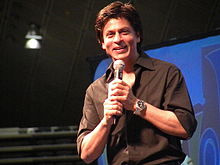 Bollywood superstar Shahrukh Khan is a non-Pashto-speaking Indian of ethnic Afghan (Pashtun) descent.[95]
Bollywood superstar Shahrukh Khan is a non-Pashto-speaking Indian of ethnic Afghan (Pashtun) descent.[95]
There are various communities who claim ethnic Afghan descent but are largely found among other ethnic groups in the south and central Asian region who generally do not speak the Pashto language. These communities are often considered overlapping groups or are simply assigned to the ethno-linguistic group that corresponds to their geographic location and mother tongue. They include some who often speak Dari (Persian), Urdu or Hindi rather than Pashto. Claimants of Pashtun heritage in South Asia have mixed with local Muslim populations and refer to themselves as "Pathan", the Hindi-Urdu variant of Pashtun.[96][97] These communities are usually partial Pashtun, to varying degrees, and often trace their Pashtun ancestry putatively through a paternal lineage. The Pathans in India have lost both the language and presumably many of the ways of their putative ancestors, but trace their fathers' ethnic heritage to the Pashtun tribes. Many Bollywood superstars are prime examples of this, especially Shahrukh Khan who is a non-Pashto-speaking Indian of ethnic Afghan (Pashtun) descent.[95]
Ayub Khan, President of Pakistan from 1958 to 1969, was a non-Pashto-speaker from the Tareen tribe of Abbottabad.
Small number of Pashtuns have adopted Hindko, Seraiki and other local Pakistani languages. These languages are often found in areas such as Abbottabad, Peshawar, Mardan, Attock, Multan and Dera Ismail Khan. After migration or establishing contacts in these areas, Pashtuns began adding new languages to their existing Pashto.[98] This group of people are bilingual in Hindko and Pashto, as well as Urdu and English in many caes. They are a large minority in major cities such as Peshawar, Kohat, Mardan, and Dera Ismail Khan, including in the mixed districts of Haripur, Abbottabad and Attock.
Some Indians claim descent from ethnic Afghan soldiers who settled in India by marrying local women during the Muslim conquest in the Indian subcontinent.[22] No specific population figures exist, as claimants of ethnic Afghan (Pashtun) descent are spread throughout the country. Notably, the Rohillas, after their defeat by the British, are known to have settled in parts of North India and intermarried with local ethnic groups. They are believed to have been bilingual in Pashto and Urdu until the mid-19th century. Some Urdu-speaking Muslims (Muhajir people) claiming descent from Pashtuns began moving to Pakistan after independence in 1947.
In Bangladesh (erstwhile East Pakistan), an unknown number of ethnic Pashtuns (together with at the later stage numbers of Iranian-speakers, these often secondary migrants from north India) settled among Bengalis from the 12th century to mid 18th century. These ethnic Afghans assimilated into Bengali culture, and intermarried with native Bengali Muslims to provide a component of the modern Bengali Muslim meme and biological identity, most prominently among the older wealthy classes of Bangladeshi Muslims. Historical structures built by Afghan descendants can still be found there. For example, the mosque of Musa Khan still remains intact in Bangladesh. He was an ethnic Pashtun and a descendant of the great Suleiman Khan, who was born in the Suleiman Mountains but moved to Bengal.[citation needed]
During the 19th century, when the British were accepting peasants from British India as indentured servants to work in the Caribbean, South Africa and other far away places, some Pashtuns from areas constituting Afghanistan and modern-day Pakistan were sent to places as far as Trinidad, Surinam, Guyana, and Fiji, to work with other Indians on the sugarcane fields and perform manual labour.[99] Many of these immigrants stayed there and formed unique communities of their own. Some of them assimilated with the other South Asian Muslim nationalities to form a common Indian Muslim community in tandem with the larger Indian community, losing their distinctive heritage. Their descendants mostly speak English and other local languages. Some ethnic Afghans travelled to as far away as Australia during the same, see Afghan (Australia).
Culture
 Khushal Khan Khattak, 17th century Pashto poet-warrior from Akora Khattak in today's Khyber Pakhtunkhwa, Pakistan.
Khushal Khan Khattak, 17th century Pashto poet-warrior from Akora Khattak in today's Khyber Pakhtunkhwa, Pakistan.
Pashtun culture is mostly based on Pashtunwali and the use or understanding of the Pashto language. Pre-Islamic traditions, dating back to Alexander's defeat of the Persian Empire in 330 BC, possibly survived in the form of traditional dances, while literary styles and music reflect influence from the Persian tradition and regional musical instruments fused with localised variants and interpretation. Pashtun culture is a unique blend of native customs with some influences from South and Western Asia.
Pashto literature, poetry and media
The Pashtuns speak Pashto as their native tongue, which is an Indo-European language. Spoken by up to 60 million people,[102] it belongs to the Iranian sub-group of the Indo-Iranian branch.[103] It can be further delineated within Eastern Iranian and Southeastern Iranian. Pashto is written in the Pashto-Arabic script and is divided into two main dialects, the southern "Pashto" and the northern "Pakhtu".
Pashto has ancient origins and bears similarities to extinct languages such as Avestan and Bactrian.[104] Its closest modern relatives include Pamir languages, such as Shughni and Wakhi, and Ossetic.[citation needed] Pashto has an ancient legacy of borrowing vocabulary from neighbouring languages including Persian and Vedic Sanskrit. Invaders have left vestiges as well; as Pashto has borrowed words from Ancient Greek, Arabic and Turkic. Modern borrowings come primarily from the English language.[105]
Fluency in Pashto is often the main determinant of group acceptance as to who is considered a Pashtun. Pashtun nationalism emerged following the rise of Pashto poetry that linked language and ethnic identity. Pashto has national status in Afghanistan and regional status in Pakistan. In addition to their native tongue, many Pashtuns are fluent in Urdu, Dari (Persian), and English.
Throughout their history, poets, prophets, kings and warriors have been among the most revered members of Pashtun society. Early written records of Pashto began to appear by the 16th century. The earliest describes Sheikh Mali's conquest of Swat.[106] Pir Roshan is believed to have written a number of Pashto books while fighting the Mughals. Pashtun scholars such as Abdul Hai Habibi and others believe that the earliest Pashto work dates back to Amir Kror Suri in the eighth century, and they use the writings found in Pata Khazana as proof. However, this is disputed by several European experts due to lack of strong evidence.
The advent of poetry helped transition Pashto to the modern period. Pashto literature gained significant prominence in the 20th century, with poetry by Ameer Hamza Shinwari who developed Pashto Ghazals.[107] In 1919, during the expanding of mass media, Mahmud Tarzi published Seraj-al-Akhbar, which became the first Pashto newspaper in Afghanistan. Some notable poets include Khushal Khan Khattak, Rahman Baba, Nazo Anaa, Ahmad Shah Durrani, Timur Shah Durrani, Shuja Shah Durrani, Ghulam Muhammad Tarzi, Afzal Khan, and Khan Abdul Ghani Khan.[108][109]
Pashto media outlets play a major role in the everyday life of Pashtuns. Several Pashto TV channels are available in the Pashtun regions, which also broadcast internationally. The leading one is AVT Khyber, helping to promote the Pashtun culture with their daily programs. Viewers around the world are informed about the day to day issues in their region and amused with their entertaining shows, such as the show with Amanullah Kaker which is based on educating Pashtuns by using messages in Pashto poetry.[110] International news sources that provide Pashto programs include BBC and Voice of America.
Recently, Pashto literature has received increased patronage, but many Pashtuns continue to rely on oral tradition due to relatively low literacy rates. Pashtun males continue to meet at Hujras, to listen and relate various oral tales of valor and history. Despite the general male dominance of Pashto oral story-telling, Pashtun society is also marked by some matriarchal tendencies.[111] Folktales involving reverence for Pashtun mothers and matriarchs are common and are passed down from parent to child, as is most Pashtun heritage, through a rich oral tradition that has survived the ravages of time.
Pashtunwali and tribalism
The term "Pakhto" or "Pashto" from which the Pashtuns derive their name is not merely the name of their language, but is synonymous with a pre-Islamic honour code formally known as Pashtunwali (or Pakhtunwali). Pashtunwali governs and regulates nearly all aspects of Pashtun life ranging from tribal affairs to individual "honor" (nang) and behaviour.
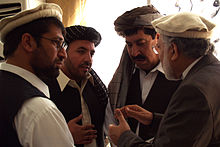 Afghan provincial governors at Jalalabad in 2009, discussing security and the reconstruction of Afghanistan. From left to right: Jamaluddin Badar of Nuristan, Lutfullah Mashal of Laghman, Gul Agha Sherzai of Nangarhar, and Fazlullah Wahidi of Kunar Province.
Afghan provincial governors at Jalalabad in 2009, discussing security and the reconstruction of Afghanistan. From left to right: Jamaluddin Badar of Nuristan, Lutfullah Mashal of Laghman, Gul Agha Sherzai of Nangarhar, and Fazlullah Wahidi of Kunar Province.
Numerous intricate tenets of Pashtunwali influence Pashtun social behaviour. One of the better known tenets is Melmastia, hospitality and asylum to all guests seeking help. Perceived injustice calls for Badal, swift revenge. A popular Pashtun saying, "Revenge is a dish best served cold", was borrowed by the British and popularised in the West.[112] Men are expected to protect Zan, Zar, Zameen (women, gold and land). Some aspects promote peaceful co-existence, such as Nanawati, the humble admission of guilt for a wrong committed, which should result in automatic forgiveness from the wronged party. Other aspects of Pashtunwali have attracted some criticism, particularly with respect to its influence on women's rights. These and other basic precepts of Pashtunwali continue to be followed by many Pashtuns, especially in rural areas.
A prominent institution of the Pashtun people is the intricate system of tribes. The Pashtuns remain a predominantly tribal people, but the worldwide trend of urbanisation has begun to alter Pashtun society as cities such as Peshawar and Quetta have grown rapidly due to the influx of rural Pashtuns and Afghan refugees.[113] Despite this trend of urbanisation, many people still identify themselves with various clans.
The tribal system has several levels of organisation: the tribe, tabar, is divided into kinship groups called khels, in turn divided into smaller groups (pllarina or plarganey), each consisting of several extended families called kahols.[114] Pashtun tribes are divided into four 'greater' tribal groups: Sarbans, Batians, Ghurghusht and Karlans.
Another prominent Pashtun institution is the Jirga or 'Senate' of elected elder men. Most decisions in tribal life are made by members of the Jirga, which is the main institution of authority that the largely egalitarian Pashtuns willingly acknowledge as a viable governing body.[115]
Pashtun celebrations and special events are also often national holidays in Pakistan and Afghanistan. A common Turko-Iranian New Year called Nouruz is often observed by Pashtuns.[116] Most prominent are Muslim holidays including Ramadan and Eid al-Fitr. Muslim holidays tend to be the most widely observed and commercial activity can come to a halt as large extended families gather in what is often both a religious duty and a festive celebration.
Religion
The overwhelming majority of Pashtuns follow Sunni Islam, belonging to the Hanafi school of thought. A tiny Shi'a community of Pashtuns exists in the northeastern section of Paktia province of Afghanistan and in neighbouring Kurram Agency of FATA, Pakistan. The Shias belong to the Turi tribe while the Bangash tribe is approximately 50% Shia and the rest Sunni, who live mainly in Kohat and the Orakzai Agency of FATA, Pakistan.
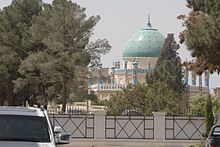 The Friday Mosque in Kandahar. Adjacent to it is the Shrine of the Cloak and the tomb of Ahmad Shah Durrani, the 18th century Pashtun conqueror who became the founding father of Afghanistan.
The Friday Mosque in Kandahar. Adjacent to it is the Shrine of the Cloak and the tomb of Ahmad Shah Durrani, the 18th century Pashtun conqueror who became the founding father of Afghanistan.
Studies conducted among the Ghilzai reveal strong links between tribal affiliation and membership in the larger ummah (Islamic community). Afghan historians believe that Pashtuns are descendants of Qais Abdur Rashid, who is purported to have been an early convert to Islam and thus bequeathed the faith to the early Pashtun population.[18][54][117] The legend says that after Qais heard of the new religion of Islam, he travelled to meet Muhammad in Medina and returned to Afghanistan as a Muslim. He purportedly had four children: Sarban, Batan, Ghourghusht and Karlan. It is believed that some Pashtuns may have been Buddhists, Zoroastrians, Hindus and Jews before Islam was introduced to them in the 7th century. However, these theories remain without conclusive evidence.
A legacy of Sufi activity may be found in some Pashtun regions, especially in the Khyber Pakhtunkhwa area, as evident in songs and dances. Many Pashtuns are prominent Ulema, Islamic scholars, such as Muhammad Muhsin Khan who has helped translate the Noble Quran, Sahih Al-Bukhari and many other books to the English language.[118] Jamal-al-Din al-Afghani was a 19th century Islamic ideologist and one of the founders of Islamic modernism. Although his ethnicity is disputed by some, he is widely accepted in the Afghanistan-Pakistan region as well as in the Arab world, as a Pashtun from the Kunar Province of Afghanistan. Like other non Arabic-speaking Muslims, many Pashtuns are able to read the Quran but not understand the Arabic language implicit in the holy text itself. Translations, especially in English, are scarcely far and in between understood or distributed. This paradox has contributed to the spread of different versions of religious practices and Wahabism, as well as political Islamism (including movements such as the Taliban) having a key presence in Pashtun society. In order to counter radicalisation and fundamentalism, the United States began English classes in Afghanistan so that Pashtuns will be able to read the English translation of Quran instead of trusting in religious scholars.[119][120] Many Pashtuns want to reclaim their identity from being lumped in with the Taliban and international terrorism, which is not directly linked with Pashtun culture and history.[121]
Lastly, little information is available on non-Muslim Pashtuns as there is limited data regarding irreligious groups and minorities, especially since many of the Hindu and Sikh Pashtuns migrated from Pakhtunkhwa after the partition of India and later, after the rise of the Taliban.[122][123] There is, however, an affirmed community of Sikh Pashtuns residing in Peshawar, Parachinar, and Orakzai Agency of FATA, Pakistan.[124] The origins of the Sikh Pashtuns are unclear. Various speculations about their origins state that they are either the descendants of Pashtun converts made by the 16th century Sikh missionary, Bhai Gurdas during his travels to Kabul, offspring of those Pashtuns whom Guru Nanak met on his voyages west of the Indus River, or the legacy of Maharaja Ranjit Singh’s huge 19th century empire, which in his own words, extended to the ‘limits of the Afghans’.[125]
Performing arts
Pashtun performers remain avid participants in various physical forms of expression including dance, sword fighting, and other physical feats. Perhaps the most common form of artistic expression can be seen in the various forms of Pashtun dances.
One of the most prominent dances is Attan, which has ancient roots possibly Greek. A rigorous exercise, Attan is performed as musicians play various native instruments including the dhol (drums), tablas (percussions), rubab (a bowed string instrument), and toola (wooden flute). With a rapid circular motion, dancers perform until no one is left dancing, similar to Sufi whirling dervishes. Numerous other dances are affiliated with various tribes notably from Pakistan including the Khattak Wal Atanrh (eponymously named after the Khattak tribe), Mahsood Wal Atanrh (which, in modern times, involves the juggling of loaded rifles), and Waziro Atanrh among others. A sub-type of the Khattak Wal Atanrh known as the Braghoni involves the use of up to three swords and requires great skill. Young women and girls often entertain at weddings with the Tumbal (tambourine).
Traditional Pashtun music has ties to Klasik (traditional Afghan music heavily inspired by Hindustani classical music), Iranian musical traditions, and other various forms found in South Asia. Popular forms include the ghazal (sung poetry) and Sufi qawwali music. Themes revolve around love and religious introspection. Modern Pashto music is centred around the city of Peshawar due to the wars in Afghanistan, and tends to combine indigenous techniques and instruments with Iranian-inspired Persian music and Indian Filmi music prominent in Bollywood. Some well known Pashto singers include Nashenas, Ubaidullah Jan Kandaharai, Sardar Ali Takkar, Naghma, Rahim Shah, Farhad Darya, Nazia Iqbal, and a number of others.
Other modern Pashtun media include an established Pashto-language film and television industry that is based in Pakistan. Producers based in Lahore have created Pashto-language films since the 1970s. Pashto films were once popular, but have declined both commercially and critically in recent years. Past films such as Yusuf Khan Sherbano dealt with serious subject matter, traditional stories, and legends. Pashtun lifestyle and issues have been raised by Western and Pashtun expatriate film-makers in recent years. One such film is In This World by British film-maker Michael Winterbottom,[126] which chronicles the struggles of two Afghan youths who leave their refugee camps in Pakistan and try to move to the United Kingdom in search of a better life. Another is the British mini-series Traffik, re-made as the American film Traffic, which featured a Pashtun man (played by Jamal Shah) struggling to survive in a world with few opportunities outside the drug trade.[127]
Sports
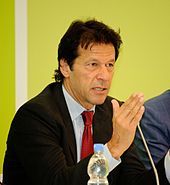 Imran Khan, who won the 1992 Cricket World Cup for Pakistan, made it to the ICC Cricket Hall of Fame in 2009 and is currently running for Prime Minister of Pakistan.
Imran Khan, who won the 1992 Cricket World Cup for Pakistan, made it to the ICC Cricket Hall of Fame in 2009 and is currently running for Prime Minister of Pakistan.
The most popular sport among the Pashtuns is cricket, which was introduced to South Asia during the early 18th century with the arrival of the British. Many Pashtuns have become prominent international cricketers and have traditionally been a Major Force of Pakistan National Cricket Team for the last several decades, such as Shahid Afridi, Imran Khan, Majid Khan, Mohsin Khan, Misbah-ul-Haq, Umar Gul, Junaid Khan and Younis Khan. also the Indian brothers Yusuf Pathan and Irfan Pathan claim to be have had Pathan Ancestary.[128] It has spread from Pakistan into Afghanistan in recent years, with many stadiums being built there. The Afghanistan national cricket team is dominated by Pashtun players.
Football (soccer) is considered the second most popular sport among the Pashtuns. The current captain of Pakistan national football team, Muhammad Essa, is an ethnic Pashtun from the Balochistan province. Another top player from the same area was Abdul Wahid Durrani, who scored 15 international goals in 13 games and became the captain of the team. The Afghanistan national football team includes a number of Pashtun players.
Some Pashtuns participate in various other sports, which may include: basketball, golf, field hockey, track and field, volleyball, handball, bodybuilding, weightlifting, wrestling (pehlwani), martial arts, boxing, skating, bowling, snooker and chess. Traditional sports include naiza bazi, which involves horsemen who compete in spear throwing. Pashtuns living in the northern regions of Afghanistan engage in Buzkashi, which is another ancient central Asian sport played by riding on horses.[129] In recent decades Hayatullah Khan Durrani, Pride of Performance caving legend from Quetta, has been promoting mountaineering, rock climbing and caving in Pakistan.
Squash is a sport in which Pashtuns from Pakistan became legend in. Jahangir Khan and Jansher Khan are former world champions of squash, making it to the Guinness World Records. They are considered to be the greatest professional squash players of all time. Although now retired, they are engaged in promoting the sport through the Pakistan Squash Federation.[130]
Snooker and billiards are played by young Pashtun men, mainly in urban areas where snooker clubs are found. Several prominent international recognised snooker players are from the Pashtun area, including Saleh Mohammed. Children's games include a form of marbles called buzul-bazi, which is played with the knucklebones of sheep. Although traditionally very less involved in sports than boys, young Pashtun girls often play volleyball, basketball, football, and cricket, especially in urban areas. A favourite game of the Pashtuns in southwestern Pakistan is yanda, mainly in and around Pishin.
Social life and other issues
In Pashtun culture, it is often considered preferable to establish interpersonal relationship with someone from the same ethnicity, but not necessarily from the same tribe. Dating, such as boyfriend and girlfriend, is more rare in Pashtun culture than in neighboring cultures but is spreading now among the elite urbanite Pashtuns due to the rapid increase of internet and mobile phone usage.
 Three defendants charged with sexual abuse of a 10-year-old boy are being escorted by a police officer inside a courtroom in Asadabad, the capital of Kunar Province in Afghanistan.
Three defendants charged with sexual abuse of a 10-year-old boy are being escorted by a police officer inside a courtroom in Asadabad, the capital of Kunar Province in Afghanistan.
Arranged marriages are usually the only choice for the rural people but also very common among those living in urban areas, although few select their own spouses.[131] Weddings are often three days events, starting with the 'henna party' on the first day, followed by the main wedding day, and ending with a gifts party on the third day. A day before the wedding, dinner is prepared for the ceremony, and the women often dye their hands with henna.[132] Wealthy Pashtuns often rent a wedding hall inside well known hotel for three days, whilst less wealthy families usually host their weddings inside the house or build a large tent outside; in most weddings, males and females sit separately. In most cases the couples getting married are young, the groom usually in the early 20s and the bride in her teens.
Although sexual abuse, prostitution, and homosexuality are serious crimes in Afghanistan and Pakistan, a report by the US military serving in Afghanistan described instances of male homosexual behaviour in the Kandahar Province. It should be noted that the same US military were involved in murdering unarmed Afghan civilians in the same province during the same year. The report went on to state that whilst the practice is known of locally, local Pashtuns completely reject the label of 'homosexual'.[133] Fox News explains that:
"Though U.S. troops are commonly taught in training for Afghanistan that the 'effeminate characteristics' of Pashtun men are 'normal' and not an indicator of homosexuality, the report said U.S. forces should not 'dismiss' the unique version of homosexuality that is actually practiced in the region 'out of desire to avoid western discomfort'."Justin Richardson, a professor of psychiatry at Columbia University, explains that calling these people homosexual is incorrect because "their decision to have sex with other men is not a reflection of what Westerners call gender identity." As in all other parts of the world, it is usually homeless street children, runaways, and orphans who end up turning to this kind of activities. In addition, all the people interviewed have denied being homosexual.[133][134] Another report that deals with LGBT rights in Pakistan mentions that in Khyber Pakhtunkhwa, Pashtun men have gained notoriety for a practice known as bacha bazi.[135] It is not known, with any accuracy, how prevalent practices like these are, some believe that prevalence is high, but others assert that it is no greater than the prevalence of homosexuality in the other ethnic groups in Pakistan and Afghanistan.[136]
Women
In Pashtun society there are three levels of women's leadership and legislative authority: the national level, the village level, and the family level. The national level includes women such as Nazo Tokhi (Nazo Anaa), Zarghona Anaa, and Malalai of Maiwand. Nazo Anaa was a prominent 17th century Pashto poet and an educated Pashtun woman who eventually became the "Mother of Afghan Nationalism" after gaining authority through her poetry and upholding of the Pashtunwali code. She used the Pashtunwali law to unite the Pashtun tribes against their Persian enemies. Her cause was picked up in the early 18th century by Zarghona Anaa, the mother of Ahmad Shah Durrani.[137]
The lives of Pashtun women vary from those who reside in conservative rural areas, such as the tribal belt, to those found in relatively freer urban centres.[138] At the village level, the female village leader is called "qaryadar". Her duties may include witnessing women's ceremonies, mobilising women to practice religious festivals, preparing the female dead for burial, and performing services for deceased women. She also arranges marriages for her own family and arbitrates conflicts for men and women.[137] Though many Pashtun women remain tribal and illiterate, others have become educated and gainfully employed.[138]
 Zeenat Karzai, wife of Hamid Karzai, representing the women of Afghanistan at a meeting in 2005, is sitting on the right next to the former First Lady of the United States, Laura Bush.
Zeenat Karzai, wife of Hamid Karzai, representing the women of Afghanistan at a meeting in 2005, is sitting on the right next to the former First Lady of the United States, Laura Bush.
The decades war and the rise of the Taliban caused considerable hardship among Pashtun women, as many of their rights were curtailed by a rigid and inaccurate interpretation of Islamic law. The difficult lives of Afghan female refugees gained considerable notoriety with the iconic image of the so-called "Afghan Girl" (Sharbat Gula) depicted on the June 1985 cover of National Geographic magazine.[139] The male-dominated code of Pashtunwali often constrains women and forces them into designated traditional roles that separate the genders.[140]
Modern social reform for Pashtun women began in the early 20th century, when Queen Soraya Tarzi of Afghanistan made rapid reforms to improve women's lives and their position in the family. Her advocacy of social reforms for women led to widespread protest and contributed to the ultimate demise of King Amanullah's reign.[141] Civil rights remained an important issue during the 1970s, as feminist leader Meena Keshwar Kamal campaigned for women's rights and founded the Revolutionary Association of the Women of Afghanistan (RAWA) in the 1977.[142]
Today, Pashtun women vary from the traditional housewives who live in seclusion to urban workers, some of whom seek or have attained parity with men.[138] But due to numerous social hurdles, the literacy rate remains considerably lower for Pashtun females than for males.[143][144] Abuse against women is present and increasingly being challenged by women's rights organisations which find themselves struggling with conservative religious groups as well as government officials in both Pakistan and Afghanistan. According to researcher Benedicte Grima's book Performance of Emotion Among Paxtun Women, "a powerful ethic of forbearance severely limits the ability of traditional Pashtun women to mitigate the suffering they acknowledge in their lives."[145]
Pashtun women often have their legal rights curtailed in favour of their husbands or male relatives. For example, though women are officially allowed to vote in Afghanistan and Pakistan, some have been kept away from ballot boxes by males.[146] Traditionally, Pashtun women have few inheritance rights and are often charged with taking care of large extended families of their spouses.[147] Another tradition that persists is swara, the giving of a female relative to someone in order to rectify a dispute. It was declared illegal in Pakistan in 2000 but continues in tribal regions.[148]
Despite obstacles, many Pashtun women have begun a process of slow change. A rich oral tradition and resurgence of poetry has inspired many Pashtun women seeking to learn to read and write.[111] Further challenging the status quo, Vida Samadzai was selected as Miss Afghanistan in 2003, a feat that was received with a mixture of support from those who back the individual rights of women and those who view such displays as anti-traditionalist and un-Islamic. Some Pashtun women have attained high political office in Pakistan.[citation needed] In Afghanistan, following recent elections, the proportion of female political representatives is one of the highest in the world.[149] A number of Pashtun women are found as TV hosts, journalists, actors and singers on several TV outlets, especially at AVT Khyber.[110] A Pashtun woman, Khatol Mohammadzai, recently became a paratrooper in the Afghan National Army Air Force, another one became a fighter pilot in the Pakistan Air Force.[150] Some notable Pashtun women of Afghanistan include Suhaila Seddiqi, Shukria Barakzai, Fauzia Gailani, Zeenat Karzai, Malalai Kakar, Naghma, and Najiba Faiz.[151]
Substantial work remains for Pashtun women to gain equal rights with men, who remain disproportionately dominant in most aspects of Pashtun society. Human rights organisations continue to struggle for greater women's rights, such as the Afghan Women's Network and the Aurat Foundation in Pakistan which aims to protect women from domestic violence.[152][153] Due to recent reforms in the higher education commission (HEC) of Pakistan, a number of competent Pashtun female scholars have been able to earn Masters and PhD scholarships. Most of them have proceeded to USA, UK and other developed countries with support from their families.[citation needed]
See also
- Pakthas
- Theory of Pashtun descent from Rajputs
- Nimat Allah al-Harawi Author of Tarikh-i-Khan Jahani Makhzan-i-Afghani (The History of the Afghans)
Notes and references
- Note: population statistics for Pashtuns (including those without a notation) in foreign countries were derived from various census counts, the UN, the CIA World Factbook and Ethnologue.
- ^ a b c Lewis, Paul M. (2009). "Pashto, Northern". SIL International. Dallas, Texas: Ethnologue: Languages of the World, Sixteenth edition. http://www.ethnologue.com/show_language.asp?code=pbu. Retrieved 18 September 2010. "Ethnic population: 49,529,000 possibly total Pashto in all countries."
- ^ a b "Pakistan Index: Tracking Variables of Reconstruction & Security". Brookings Institution. 29 June 2011. http://www.brookings.edu/~/media/Files/Programs/FP/pakistan%20index/index.pdf. Retrieved 26 July 2011.
- ^ "Afghan Population: 28,395,716 [Pashtun 42%"]. Central Intelligence Agency (CIA). The World Factbook. https://www.cia.gov/library/publications/the-world-factbook/fields/2119.html?countryName=Afghanistan&countryCode=af®ionCode=sas&#af. Retrieved 8 September 2010.
- ^ "United Arab Emirates: Demography". Encyclopædia Britannica World Data. Encyclopædia Britannica Online. http://www.britannica.com/new-multimedia/pdf/wordat207.pdf. Retrieved 15 March 2008.
- ^ "Ethnologue report for Southern Pashto: Iran (1993)". SIL International. Ethnologue: Languages of the World. http://www.ethnologue.com/. Retrieved 8 September 2010.
- ^ Maclean, William (10 June 2009). "Support for Taliban dives among British Pashtuns". Reuters. http://www.reuters.com/article/latestCrisis/idUSL861250. Retrieved 6 August 2009.
- ^ "Ethnic origins, 2006 counts, for Canada". 2.statcan.ca. 2006. http://www12.statcan.ca/english/census06/data/highlights/ethnic/pages/Page.cfm?Lang=E&Geo=PR&Code=01&Data=Count&Table=2&StartRec=1&Sort=3&Display=All&CSDFilter=5000. Retrieved 17 April 2010.
- ^ a b "Abstract of speakers’ strength of languages and mother tongues – 2001". Census of India. 2001. http://www.censusindia.gov.in/Census_Data_2001/Census_Data_Online/Language/Statement1.htm. Retrieved 17 March 2008.
- ^ "Language Spoken at Home". US Census Bureau. 2001. http://www.census.gov/mp/www/spectab/languagespokenSTP224.xls. Retrieved 15 March 2008.
- ^ "Afghanistan: Pashtun, Southern of Afghanistan". Joshua Project. http://www.joshuaproject.net/people-profile.php. Retrieved 10 September 2010.
- ^ "Afghanistan: Glossary". British Library. http://www.bl.uk/reshelp/findhelpregion/asia/afghanistan/afghanistancollection/afghansources/afghanglossary.html. Retrieved 15 March 2008. "Comes to mean Pathans residing in Pakistan and Afghanistan. Divided into two main groups, the Abdalis (qv) and the Ghilzais (qv)."
- ^ a b c d Sabahuddin, Abdul (2008). History of Afghanistan. Global Vision Publishing Ho. p. 15. ISBN 8182202469. http://books.google.com/books?id=XfDYtxfOvTYC&lpg=PP1&pg=PA15#v=onepage&q&f=false. Retrieved 23 September 2010.
- ^ a b Nath, Samir (2002). Dictionary of Vedanta. Sarup & Sons. p. 273. ISBN 8178900564. http://books.google.com/books?id=yGBaXO54-HwC&lpg=PP1&pg=PA273#v=onepage&q&f=false. Retrieved 10 September 2010.
- ^ a b "The History of Herodotus Chapter 7". Translated by George Rawlinson. The History Files. 440 BC. http://www.piney.com/Heredotus7.html. Retrieved 10 January 2007.
- ^ a b c d "Afghan and Afghanistan". Abdul Hai Habibi. alamahabibi.com. 1969. http://www.alamahabibi.com/English%20Articles/Afghan_and_Afghanistan.htm. Retrieved 24 October 2010.
- ^ a b "History of Afghanistan". Encyclopædia Britannica Online. http://www.britannica.com/EBchecked/topic/7798/Afghanistan/129450/History?anchor=ref261360. Retrieved 22 November 2010.
- ^ a b "Afghan". Ch. M. Kieffer. Encyclopædia Iranica Online Edition. 15 December 1983. http://www.iranica.com/articles/afgan-in-current-political-usage-any-citizen-of-afghanistan-whatever-his-ethnic-tribal-or-religious-affiliation. Retrieved 27 September 2010.
- ^ a b c d Muhammad Qasim Hindu Shah (Firishta). "History of the Mohamedan Power in India". Persian Literature in Translation. Packard Humanities Institute. http://persian.packhum.org/persian/pf?file=06901021&ct=10. Retrieved 10 January 2007.
- ^ a b Romano, Amy (2003). A Historical Atlas of Afghanistan. The Rosen Publishing Group. p. 28. ISBN 0823938638. http://books.google.com/books?id=TKUxyVCrYn0C&lpg=PP1&pg=PA28#v=onepage&q&f=false. Retrieved 17 October 2010.
- ^ a b Louis Dupree, Nancy Hatch Dupree and others. "Last Afghan empire". Encyclopædia Britannica Online. http://www.britannica.com/EBchecked/topic/7798/Afghanistan/21392/Last-Afghan-empire. Retrieved 10 September 2010.
- ^ Syed Saleem Shahzad (20 October 2006). "Profiles of Pakistan's Seven Tribal Agencies". http://www.jamestown.org/programs/gta/single/?tx_ttnews%5Btt_news%5D=891&tx_ttnews%5BbackPid%5D=181&no_cache=1. Retrieved 22 April 2010.
- ^ a b Study of the Pathan Communities in Four States of India, Khyber.org. Retrieved 30 January 2008.
- ^ "Ethnic map of Afghanistan" (PDF). Thomas Gouttierre, Center For Afghanistan Studies, University of Nebraska at Omaha; Matthew S. Baker, Stratfor. National Geographic Society. 2003. http://ngm.nationalgeographic.com/ngm/0311/feature2/images/mp_download.2.pdf. Retrieved 24 October 2010.
- ^ Sharmeen Obaid-Chinoy (17 July 2009). "Pakistan: Karachi's Invisible Enemy City potent refuge for Taliban fighters". Frontline on PBS. http://www.pbs.org/frontlineworld/rough/2009/07/karachis_invisi.html. Retrieved 15 March 2008.
- ^ Syed Saleem Shahzad (10 Jan 2007). "How the Taliban keep their coffers full". http://atimes.com/atimes/South_Asia/IA10Df02.html. Retrieved 10 September 2010.
- ^ 300 Pashtuns held in crackdown, The Nation. 8 April 2009.
- ^ "Ethnic groups". The World Factbook. Central Intelligence Agency (CIA). https://www.cia.gov/library/publications/the-world-factbook/fields/2075.html?countryName=Afghanistan&countryCode=af®ionCode=sas&#af. Retrieved 8 September 2010.
- ^ Janda, Kenneth; Jeffrey M. Berry and Jerry Goldman (2008). The Challenge of Democracy: Government in America (9 ed.). Cengage Learning. p. 46. ISBN 061881017X. http://books.google.com/books?id=_WlzlY9dv74C&lpg=PP1&pg=PA46#v=onepage&q&f=false. Retrieved 22 August 2010. "Even within the largest ethnic group, the Pashtuns (about 50 percent of the population)...""
- ^ Congressional Record. Government Printing Office. p. 10088. http://books.google.com/books?id=qImZpu07_UEC&lpg=PA9979&pg=PA10088#v=onepage&q&f=false. Retrieved 24 September 2010.
- ^ Taylor, William J. Jr.; Abraham Kim (2000). Asian Security to the Year 2000. DIANE Publishing. p. 58. ISBN 1428913688. http://books.google.com/books?id=peTWtThUljQC&lpg=PR1&pg=PA58#v=onepage&q&f=false. Retrieved 24 September 2010.
- ^ "AFGHANISTAN v. Languages". Ch. M. Kieffer. Encyclopædia Iranica. http://www.iranica.com/articles/afghanistan-v-languages. Retrieved 24 October 2010. "Paṧtō (1) is the native tongue of 50 to 55 percent of Afghans..."
- ^ Brown, Keith; Sarah Ogilvie (2009). Concise encyclopedia of languages of the world. Elsevie. p. 845. ISBN 0080877745. http://books.google.com/books?id=F2SRqDzB50wC&lpg=PP1&pg=PA845#v=onepage&q&f=false. Retrieved 24 September 2010. "Pashto, which is mainly spoken south of the mountain range of the Hindu Kush, is reportedly the mother tongue of 60% of the Afghan population."
- ^ Hawthorne, Susan; Bronwyn Winter (2002). September 11, 2001: feminist perspectives. Spinifex Press. p. 225. ISBN 1876756276. http://books.google.com/books?id=DwbfD_irV_AC&lpg=PP1&pg=PA225#v=onepage&q&f=false. Retrieved 24 September 2010. "Over 60 percent of the population in Afghanistan is Pashtun..."
- ^ "2010 UNHCR country operations profile – Pakistan". United Nations High Commissioner for Refugees (UNHCR). 2010. http://www.unhcr.org/cgi-bin/texis/vtx/page?page=49e487016. Retrieved 17 April 2010.
- ^ "2010 UNHCR country operations profile – Islamic Republic of Iran". United Nations High Commissioner for Refugees (UNHCR). 2010. http://www.unhcr.org/cgi-bin/texis/vtx/page?page=49e486f96. Retrieved 17 April 2010.
- ^ "The Afghans – Their History and Culture". Barbara Robson, Juliene Lipson, Farid Younos, Mariam Mehdi. United States: Center for Applied Linguistics (CAL). 30 June 2002. http://www.cal.org/co/afghan/ahist.html. Retrieved 10 September 2010.
- ^ "Country Profile: Afghanistan". Library of Congress. Library of Congress Country Studies on Afghanistan. August 2008. http://lcweb2.loc.gov/frd/cs/profiles/Afghanistan.pdf. Retrieved 10 September 2010.
- ^ "Kingdoms of South Asia – Afghanistan (Southern Khorasan / Arachosia)". The History Files. http://www.historyfiles.co.uk/KingListsMiddEast/EasternAfghans.htm. Retrieved 16 August 2010.
- ^ John Ford Shroder. "Afghanistan – VII. History". http://www.webcitation.org/5kwDUj6WJ. Retrieved 31 October 2009.
- ^ a b "Pashtun: also spelled Pushtun, or Pakhtun, Hindustani Pathan, Persian Afghan". Encyclopædia Britannica Online. http://www.britannica.com/ebc/article-9374656?query=Herder&ct=. Retrieved 10 September 2010. "The origins of the Pashtun are unclear. Pashtun tradition asserts that they are descended from Afghana, grandson of King Saul of Israel, though most scholars believe it more likely that they arose from an intermingling of ancient Aryans from the north or west with subsequent invaders."
- ^ Lal, Mohan (1846). Life of the Amir Dost Mohammed Khan; of Kabul. Volume 1.. Crabtree Publishing Company. p. 3. ISBN 0778793354. http://www.archive.org/stream/lifeofamirdostmo01mohauoft/lifeofamirdostmo01mohauoft_djvu.txt. Retrieved 10 September 2010.
- ^ a b c Vogelsang, Willem (2002). The Afghans. Wiley-Blackwell. p. 18. ISBN 0631198415. http://books.google.com/books?id=9kfJ6MlMsJQC&lpg=PP1&pg=PA18#v=onepage&q&f=false. Retrieved 22 August 2010.
- ^ Dani, Ahmad Hasan (2007). History of Pakistan: Pakistan through ages. Sang-e Meel Publications. p. 77. ISBN 9693520203. http://books.google.com/?id=9yduAAAAMAAJ. Retrieved 10 September 2010.
- ^ a b Houtsma, Martijn Theodoor (1987). E.J. Brill's first encyclopaedia of Islam, 1913–1936. 2. BRILL. p. 150. ISBN 9004082654. http://books.google.com/books?id=GEl6N2tQeawC&lpg=PP1&pg=PA150#v=onepage&q&f=false. Retrieved 24 September 2010.
- ^ a b Noelle-Karimi, Christine; Conrad J. Schetter, Reinhard Schlagintweit (2002). Afghanistan -a country without a state?. IKO. p. 18. ISBN 3889396283. http://books.google.com/?id=eo3tAAAAMAAJ. Retrieved 24 September 2010. "The earliest mention of the name 'Afghan' (Abgan) is to be found in a Sasanid inscription from the third century AD, and it appears in India in the form of 'Avagana'..."
- ^ a b c "The Pashtuns". Barbara Robson, Juliene Lipson, Farid Younos, Mariam Mehdi. United States: Center for Applied Linguistics (CAL). 30 June 2002. http://www.cal.org/co/afghan/apeop.html#1. Retrieved 10 September 2010.
- ^ "Claims About Origin". Syed Zubir Rehman. pakhtun.com. http://www.pakhtun.com/index.php/about-pashtuns/origins-of-pashtuns/pashtun-origins?start=1. Retrieved 24 October 2010.
- ^ Dawn News, The cradle of Pathan culture
- ^ "Islamic conquest". Library of Congress Country Studies on Afghanistan. 1997. http://lcweb2.loc.gov/cgi-bin/query/r?frd/cstdy:@field(DOCID+af0006). Retrieved 10 September 2010.
- ^ V. Minorsky. "The Turkish dialect of the Khalaj". University of London. pp. 417–437. http://www.khyber.org/articles/2005/TheKhalajWestoftheOxus.shtml. Retrieved 10 January 2007.
- ^ Houtsma, Martijn Theodoor (1987). E.J. Brill's first encyclopaedia of Islam, 1913–1936. 2. BRILL. p. 151. ISBN 9004082654. http://books.google.com/books?id=GEl6N2tQeawC&lpg=PP1&pg=PA151#v=onepage&q&f=false. Retrieved 24 September 2010.
- ^ Travels in Asia and Africa, 1325–1354 (reprint, illustrated ed.). Routledge. 2004. p. 180. ISBN 0415344735. http://books.google.com/books?id=zKqn_CWTxYEC&lpg=PP1&pg=PA180#v=onepage&q&f=false. Retrieved 10 September 2010.
- ^ Muhammad Qasim Hindu Shah (1560-16-20). "The History of India, Volume 6, chpt. 200, Translation of the Introduction to Firishta's History (p.8)". Sir H. M. Elliot. London: Packard Humanities Institute. http://persian.packhum.org/persian/pf?file=80201016&ct=199. Retrieved 22 August 2010.
- ^ a b Life of the Amir Dost Mohammed Khan; of Kabul, Volume 1. By Mohan Lal (1846), pg.5
- ^ Alden Oreck. "The Virtual Jewish History Tour, Afghanistan". Jewish Virtual Library. http://www.jewishvirtuallibrary.org/jsource/vjw/Afghanistan.html. Retrieved 10 January 2007.
- ^ Caroe, Olaf. 1984. The Pathans: 500 B.C.-A.D. 1957 (Oxford in Asia Historical Reprints)." Oxford University Press.
- ^ Mansoor A, Mazhar K, Khaliq S, et al. (April 2004). "Investigation of the Greek ancestry of populations from northern Pakistan". Hum Genet 114 (5): 484–90. doi:10.1007/s00439-004-1094-x. PMID 14986106.
- ^ Ethnic Groups, Pashtun, Library of Congress Country Studies on Afghanistan
- ^ "Language Roots". Barbara Robson, Juliene Lipson, Farid Younos, Mariam Mehdi. United States: Center for Applied Linguistics (CAL). 30 June 2002. http://www.cal.org/co/afghan/alang.html. Retrieved 10 September 2010.
- ^ "Old Iranian Online". University of Texas at Austin. http://www.utexas.edu/cola/centers/lrc/eieol/aveol-0-X.html. Retrieved 10 February 2007.
- ^ Gankovsky, Yu. V. (1982). A History of Afghanistan. Progress Publishers. p. 382.
- ^ Quddus, Syed Abdul (1987). The Pathans. Moscow: Ferozsons. p. 29. http://books.google.com/?id=EoBCAAAAYAAJ. Retrieved 25 October 2010.
- ^ Sengupta S, Zhivotovsky LA, King R, et al. (2006). "Polarity and temporality of high-resolution y-chromosome distributions in India identify both indigenous and exogenous expansions and reveal minor genetic influence of central asian pastoralists". Am. J. Hum. Genet. 78 (2): 202–21. doi:10.1086/499411. PMC 1380230. PMID 16400607. http://www.pubmedcentral.nih.gov/articlerender.fcgi?tool=pmcentrez&artid=1380230.
- ^ Firasat S, Khaliq S, Mohyuddin A, et al. (2007). "Y-chromosomal evidence for a limited Greek contribution to the Pathan population of Pakistan". Eur. J. Hum. Genet. 15 (1): 121–6. doi:10.1038/sj.ejhg.5201726. PMC 2588664. PMID 17047675. http://www.pubmedcentral.nih.gov/articlerender.fcgi?tool=pmcentrez&artid=2588664.
- ^ "YHRD.org: Result for haplotype 16-13-30-23-11-11-13—1--1—1". http://www.yhrd.org/rcms/navigation/1000081.html?dys19=16&dys389i=13&dys389ii=30&dys390=23&dys391=11&dys392=11&dys393=13&dys385=-1&dys438=-1&dys439=-1&release=*&geogroup=*.
- ^ "YHRD.org: Result for haplotype 17-13-30-23-11-11-13—1--1—1". http://www.yhrd.org/rcms/navigation/1000081.html?dys19=17&dys389i=13&dys389ii=30&dys390=23&dys391=11&dys392=11&dys393=13&dys385=-1&dys438=-1&dys439=-1&release=*&geogroup=*.
- ^ Firasat S, Khaliq S, Mohyuddin A, et al. (January 2007). "Y-chromosomal evidence for a limited Greek contribution to the Pathan population of Pakistan". Eur J Hum Genet. 15 (1): 121–6. doi:10.1038/sj.ejhg.5201726. PMC 2588664. PMID 17047675. http://www.pubmedcentral.nih.gov/articlerender.fcgi?tool=pmcentrez&artid=2588664.
- ^ McCarthy, Rory (17 January 2010). "Pashtun clue to lost tribes of Israel". The Guardian (London). http://www.guardian.co.uk/world/2010/jan/17/israel-lost-tribes-pashtun. Retrieved 7 June 2009.
- ^ Parashar, Sachin (11 January 2010). "Lucknow Pathans have Jewish roots?". The Times of India (India). http://timesofindia.indiatimes.com/india/Lucknow-Pathans-have-Jewish-roots/articleshow/5431654.cms. Retrieved 7 June 2009.
- ^ a b "Link between Israel's lost tribes and Pashtuns of Af-Pak to be genetically analyzed". Newkerala.com. http://www.newkerala.com/news/fullnews-36199.html. Retrieved 17 April 2010.
- ^ Ricaut, F. et al. 2004. Genetic Analysis of a Scytho-Siberian Skeleton and Its Implications for Ancient Central Asian Migrations. Human Biology. 76 (1): 109–125
- ^ Bouakaze, 2009 :Pigment phenotype and biogeographical ancestry from ancient skeletal remains: inferences from multiplexed autosomal SNP analysis
- ^ Ricaut,F. et al. 2004. Genetic Analysis and Ethnic Affinities From Two Scytho-Siberian Skeletons. American Journal of Physical Anthropology. 123:351–360
- ^ Clisson, I. et al. 2002. Genetic analysis of human remains from a double inhumation in a frozen kurgan in Kazakhstan (Berel site, Early 3rd century BC). International Journal of Legal Medicine. 116:304–308
- ^ Keyser, Christine (16 May 2009). "Ancient DNA provides new insights into the history of south Siberian Kurgan people". Human Genetics. http://www.springerlink.com/content/4462755368m322k8/?p=087abdf3edf548a4a719290f7fc84a62&pi=0. Retrieved 6 April 2010.
- ^ Edward G. Browne, M.A., M.B.. "A Literary History of Persia, Volume 4: Modern Times (1500–1924), Chapter IV. An Outline Of The History Of Persia During The Last Two Centuries (A.D. 1722–1922)". London: Packard Humanities Institute. http://persian.packhum.org/persian/main?url=pf%3Ffile%3D90001014%26ct%3D29. Retrieved 9 September 2010.
- ^ Ramesh Chopra (2005). Dictionary Of History. Isha Books. http://books.google.com/books?id=O9CEdtDrxHYC&pg=PA31&dq=Ashfaqulla+Khan+Pathan&hl=en&ei=WSl0TqzXAcnX0QGt3cWmDQ&sa=X&oi=book_result&ct=result&resnum=3&ved=0CD0Q6AEwAg#v=onepage&q=Ashfaqulla%20Khan%20Pathan&f=false. Retrieved 17 September 2011. "Ashfaqulla Khan : The Pathan patriot who kissed the hangman's noose with the name of Allah on his lips. A youth endowed with a body of iron and will of steel, he dedicated everything to the service of India and of freedom and challenged the cunning and the strength of an empire."
- ^ "Abdul Ghaffar Khan". Encyclopædia Britannica Online. http://www.britannica.com/EBchecked/topic/232353/Khan-Abdul-Ghaffar-Khan. Retrieved 24 September 2008.
- ^ "Abdul Ghaffar Khan". I Love India. http://www.iloveindia.com/indian-heroes/abdul-ghaffar-khan.html. Retrieved 24 September 2008.
- ^ "People and Tribes". http://nwfp.gov.pk/nwfpgov/aboutus/People-Tribles.php.
- ^ "Mohammad Yousaf Khan Khattak". http://www.pakpost.gov.pk/philately/stamps2003/mohammad_yousaf_khan_khattak.html.
- ^ Afghanistan: At the Crossroads of Ancient Civilisations, BBC. Retrieved 10 October 2006.
- ^ Afghan Government 2009, Central Intelligence Agency (CIA)
- ^ Sharma, Vishwamitra (2007). Famous Indians of the 21st century. Pustak Mahal. p. 60. ISBN 8122308295. http://books.google.com/books?id=jx1XJp6wOFAC&lpg=PP1&pg=PA60#v=onepage&q&f=false. Retrieved 18 September 2010.
- ^ Fārūqī, Z̤iāʼulḥasan (1999). Dr. Zakir Hussain, quest for truth (by Ziāʼulḥasan Fārūqī). APH Publishing. p. 8. ISBN 8176480568. http://books.google.com/books?id=uzNnwUasQ3wC&lpg=PP1&pg=PA8#v=onepage&q&f=false. Retrieved 18 September 2010.
- ^ Johri, P.K (1999). Educational thought. Anmol Publications PVT. LTD. p. 267. ISBN 8126121750. http://books.google.com/books?id=dAYxGg0w8xMC&lpg=PP1&pg=PA267#v=onepage&q&f=false. Retrieved 18 September 2010.
- ^ "To Islamabad and the Frontier". The Hindu (Chennai, India). 26 May 2003. http://www.hindu.com/thehindu/2003/05/26/stories/2003052600431000.htm. Retrieved 1 August 2007.
- ^ Darbari, Raj (1983). Commonwealth and Nehru. Vision Books. p. 28. ISBN 8126121750. http://books.google.com/?id=gSYhAAAAMAAJ&q=Mohammad+Yunus+pathan&dq=Mohammad+Yunus+pathan&cd=16. Retrieved 20 April 2008.
- ^ The Pathan unarmed: opposition & memory in the North West Frontier (Khyber Pakhtunkhwa). James Currey. "He was visiting his cousin Mohammed Yunus, a Pathan who had chosen to move to Delhi at Partition and become a well-known figure in the Congress regime."
- ^ Encyclopædia of Muslim Biography. A.P.H. Pub. Corp.. "Mohammad Yunus is belong to a rich and distinguished Pathan family and son of Haji Ghulam Samdani (1827–1926)."
- ^ a b "Pashtun". Encyclopædia Britannica Online Edition. http://www.britannica.com/eb/article-9058636/Pashtun. Retrieved 18 January 2007.
- ^ "Pakistan: Pakhtuns". Library of Congress Country Studies. http://lcweb2.loc.gov/cgi-bin/query/r?frd/cstdy:@field(DOCID+pk0053). Retrieved 18 January 2007.
- ^ "The Pashtun Code". The New Yorker. Archived from the original on 17 November 2006. http://web.archive.org/web/20061117130055/http://www.newyorker.com/fact/content/articles/011203fa_FACT1. Retrieved 18 January 2007.
- ^ Krastev, Nikola (19 June 2007). "U.S.: Afghan Jews Keep Traditions Alive Far From Home". RFE/RL. http://www.rferl.org/featuresarticle/2007/6/c837c590-c06b-4c30-9017-36f29fc98437.html. Retrieved 17 April 2010.
- ^ a b "SRK to Amar Singh: Don't you scare my kids". Rediff. 16 March 2007. http://www.rediff.com/movies/2007/mar/16srk.htm. Retrieved 5 July 2006.
- ^ "Memons, Khojas, Cheliyas, Moplahs.... How Well Do You Know Them?". Islamic Voice (magazine). http://www.islamicvoice.com/may.2003/cseries.htm. Retrieved 18 January 2007.
- ^ "Pathan". Houghton Mifflin Company. http://www.thefreedictionary.com/Pathan. Retrieved 7 November 2007.
- ^ Shackle, C. (1980). Bulletin of the School of Oriental and African Studies. 43 (3 ed.). Cambridge University Press. pp. 482–510. http://links.jstor.org/sici?sici=0041-977X(1980)43%3A3%3C482%3AHIKAP%3E2.0.CO%3B2-M. Retrieved 18 January 2007.
- ^ "Afghans of Guyana". Wahid Momand. Afghanland.com. http://afghanland.com/culture/guyana.html. Retrieved 18 January 2007.
- ^ Afghan Monarchs: Sher Shah Suri, Amanullah Khan, Habibullah Khan, Amir Kror Suri. London: General Books. 2010. pp. 26. ISBN 1156384257, 9781156384251. http://books.google.com/books?id=bDSWSQAACAAJ&source=gbs_navlinks_s. Retrieved 26 September 2010.
- ^ Afghanistan. 20–22. Historical Society of Afghanistan. 1967. p. 47. http://books.google.com/books?id=zhrjAAAAMAAJ&source=gbs_navlinks_s. Retrieved 26 September 2010.
- ^ Penzl, Herbert; Ismail Sloan (2009). A Grammar of Pashto a Descriptive Study of the Dialect of Kandahar, Afghanistan. Ishi Press International. pp. 210. ISBN 0923891722. http://books.google.com/?id=zvRePgAACAAJ. Retrieved 25 October 2010. "Estimates of the number of Pashto speakers range from 40 million to 60 million..."
- ^ Pashto language, alphabet and pronunciation, Omniglot. Retrieved 18 January 2007.
- ^ Avestan language, Encyclopaedia Britannica. Retrieved 18 February 2007.
- ^ Awde, Nicholas and Asmatullah Sarwan. 2002. Pashto: Dictionary & Phrasebook, New York: Hippocrene Books Inc. ISBN 0-7818-0972-X. Retrieved 18 February 2007.
- ^ History of Pushto language, UCLA Language Materials Project. Retrieved 18 January 2007.
- ^ Amir Hamza Shinwari Baba, Khyber.org. Retrieved 18 January 2007.
- ^ Afghanistan Online, Classical Dari and Pashto Poets
- ^ "Rahman Baba: Poet of the Pashtuns". Archived from the original on 17 April 2007. http://web.archive.org/web/20070417172354/http://www.pashto.org/content/view/12/26/. Pashto.org. Retrieved 18 January 2007.
- ^ a b AVT Khyber, Link
- ^ a b The tale of the Pashtun poetess, Leela Jacinto, The Boston Globe, 22 May 2005. Retrieved 18 January 2007.
- ^ Halliday, Tony (ed.). 1998. Insight Guide Pakistan, Duncan, South Carolina: Langenscheidt Publishing Group. ISBN . Retrieved 19 February 2007.
- ^ How Ethno-Religious Identity Influences the Living Conditions of Hazara and Pashtun Refugees in Peshawar, Pakistan, Department of Urban Studies and Planning, MIT . Retrieved 10 October 2006.
- ^ Jirga – A Traditional Mechanism of Conflict Resolution in Afghanistan by Ali Wardak, un.org (2003), p. 7. Retrieved 10 October 2006.
- ^ Q & A on Afghanistan's Loya Jirga Process, Human Rights Watch. Retrieved 10 October 2006.
- ^ Noruz, Encyclopaedia Britannica . Retrieved 10 October 2006.
- ^ Meaning and Practice, Afghanistan Country Study: Religion, Illinois Institute of Technology. Retrieved 18 January 2007.
- ^ The Noble Quran (in 9 VOLUMES), Arabic-English, (ed. Dr. Muhammad Muhsin Khan). Retrieved 18 January 2007.
- ^ U.S. Embassy in Kabul
- ^ 110605-F-BH761-037 Isafmedia.
- ^ Pashtuns want an image change (BBC News article by Ahmed Rashid 2006)
- ^ Ali, Tariq (2003). The clash of fundamentalisms: crusades, jihads and modernity. Verso. ISBN 9781859844571. http://books.google.com/?id=C8h_VjG4ucsC&pg=PA20&dq=Hindu+Pashtuns&cd=13#v=onepage&q=Hindu%20Pashtuns. Retrieved 20 April 2008. "The friends from Peshawar would speak of Hindu and Sikh Pashtuns who had migrated to India. In the tribal areas – the no man's land between Afghanistan and Pakistan – quite a few Hindus stayed on and were protected by the tribal codes. The same was true in Afghanistan itself (till the mujahidin and the Taliban arrived)."
- ^ Trimbur, John (10 August 2004). The call to write. Pearson Longman. ISBN 9780321203052. http://books.google.com/?id=_Xk6lGaMvswC&q=Sikh+Pashtuns&dq=Sikh+Pashtuns&cd=4. Retrieved 20 April 2008. "The friends from Peshawar would speak of Hindu and Sikh Pashtuns who had migrated to India. In the tribal areas – the no-man's – land between Afghanistan and Pakistan – quite a few Hindus stayed on and were protected by the tribal codes. The same was true in Afghanistan itself (till the mujahidin and the Taliban arrived)."
- ^ "The Frontier Singhs". Newsline Publications (Pvt.) Ltd.. http://www.newsline.com.pk/NewsOct2008/sprepoct.htm. Retrieved 7 June 2009. "There is a small Sikh community in the largely ungoverned Orakzai tribal region, while a few live in Kurram's regional headquarters of Parachinar. They consider themselves "sons of the soil" – Pashtuns to be more specific – and are identified as such. "We are proud to be Pashtuns," says Sahib Singh. "Pashto is our tongue, our mother tongue – and we are proud of it.""
- ^ Empires of the Indus: The Story of a River, Alice Albinia, W. W. Norton & Company, 2010, p. 113
- ^ Michael Winterbottom Talks About His Tragic Road Movie, "In This World", Indiewire.com . Retrieved 18 January 2007.
- ^ Traffik, IMDb . Retrieved 18 January 2007.
- ^ Adams, Tim (2 July 2006). "The path of Khan". The Observer (London). http://www.guardian.co.uk/sport/2006/jul/02/cricket.features3. Retrieved 18 January 2007. "Not long after his cricket career ended Imran visited those tribal homelands for the first time to write a book about the warrior race of which he is a distant cousin... "As I got to know the Pathans' character," he says, "I recognised in it the competitiveness I was born with and the determination not to show fear.""
- ^ "Afghanistan to Bosnia Herzegovina – Pashtun". Everycultur.com. http://www.everyculture.com/wc/Afghanistan-to-Bosnia-Herzegovina/Pashtun.html. Retrieved 18 January 2007.
- ^ "Jansher joins hands with PSF". Pak Tribune. 1 December 2010. http://www.paktribune.com/news/index.shtml?234010. Retrieved 4 December 2010.
- ^ Afghan Frontier: At the Crossroads of Conflict, by Victoria Schofield, p 208
- ^ My life with the Taliban, Abdul Salam Zaeef, ʻAbd al-Salām Z̤aʻīf, Alex Strick van Linschoten, Felix Kuehn, p xiv
- ^ a b Fox News: Afghan sexual identity
- ^ Kandahar’s Lightly Veiled Homosexual Habits
- ^ open secrets, Boston Globe
- ^
- Foucault and the Iranian Revolution: gender and the seductions of Islamism By Janet Afary, Kevin Anderson, Michel Foucault, p 157
- Compassion: the culture and politics of an emotion By Lauren Gail Berlant, p 213
- Ethnicity and family therapy By Monica McGoldrick, Joseph Giordano, Nydia Garcia-Preto, p 416
- Denied by many Pashtuns: Empires of the Indus: The Story of a River By Alice Albinia, p 42
- Western newspapers have reported that after the fall of the Taliban regime in Afghanistan local Afghans complained about the comeback of a series of sexual practices including "the Pashtun obsession with sodomy" and dandyism, paedophilia, homosexual, rape and gay activity: Owens, Patriciat. 2010. Torture, Sex and Military Orientalism. Third World Quarterly Vol. 31, No. 7.
- ^ a b Harvard University, Tribal Law of Pashtunwali and Women’s Legislative Authority
- ^ a b c I have a right to, BBC World Service, Fri 16 January 2006. Retrieved 10 October 2006.
- ^ Along Afghanistan's War-torn Frontier, National Geographic, June 1985 . Retrieved 10 October 2006.
- ^ Afghan teacher and public servant gunned down by the Taliban outside her home, The Guardian, 16 January 2006. Retrieved 10 October 2006.
- ^ "A History of Women in Afghanistan: Lessons Learnt for the Future". Dr. Huma Ahmed-Ghosh. Aletta. May 2003. http://www.iiav.nl/ezines/web/JournalofInternationalWomensStudies/2003/Vol4Nr3May/Afghanistan.pdf. Retrieved 2 December 2010.
- ^ Making Waves: Interview with RAWA, RAWA.org, Fri 16 January 2006. Retrieved 10 October 2006.
- ^ Population by Level of Education and Gender, Pakistan Census, Fri 16 January 2006 . Retrieved 10 October 2006.
- ^ Laura Bush Meets Afghan Women, CBS News, Fri 16 January 2006. Retrieved 10 October 2006.
- ^ Grima, Benedicte. 1992. Performance of Emotion Among Paxtun Women, University of Texas Press. ISBN 0292727569. Retrieved 10 October 2006.
- ^ I have a right to – Muhammad Dawood Azami: Pashto, BBC World Service . Retrieved 10 October 2006.
- ^ Afghanistan Country Study: Family, Government Documents Depository Website, Paul V. Galvin Library, Illinois Institute of Technology . Retrieved 10 October 2006.
- ^ Pakistani Girls Forced to Settle Men's Disputes, Khaleej Times, Fri 16 April 2004 (Alternatives.ca). Retrieved 10 October 2006.
- ^ Warlords and women in uneasy mix, Andrew North, BBC News, 14 November 2005. Retrieved 10 October 2006.
- ^ Abbas, Zaffar (11 May 2005). "Pakistan's first women fighter pilots". BBC News. http://news.bbc.co.uk/2/hi/south_asia/4533367.stm. Retrieved 10 October 2006.
- ^ Najiba Faiz
- ^ About AWN, Afghan Women's Network. Retrieved 10 October 2006.
- ^ Aurat Publication and Information Service Foundation, Aurat Foundation, Fri 16 January 2006. Retrieved 10 October 2006.
Further reading
- Ahmad, Aisha and Boase, Roger. 2003. "Pashtun Tales from the Pakistan-Afghan Frontier: From the Pakistan-Afghan Frontier." Saqi Books (1 March 2003). ISBN 0-86356-438-0.
- Ahmed, Akbar S. 1976. "Millennium and Charisma among Pathans: A Critical Essay in Social Anthropology." London: Routledge & Kegan Paul.
- Ahmed, Akbar S. 1980. "Pukhtun economy and society." London: Routledge and Kegan Paul.
- Banuazizi, Ali and Myron Weiner (eds.). 1994. "The Politics of Social Transformation in Afghanistan, Iran, and Pakistan (Contemporary Issues in the Middle East)." Syracuse University Press. ISBN 0-8156-2608-8.
- Banuazizi, Ali and Myron Weiner (eds.). 1988. "The State, Religion, and Ethnic Politics: Afghanistan, Iran, and Pakistan (Contemporary Issues in the Middle East)." Syracuse University Press. ISBN 0-8156-2448-4.
- Caroe, Olaf. 1984. The Pathans: 500 B.C.-A.D. 1957 (Oxford in Asia Historical Reprints)." Oxford University Press. ISBN 0-19-577221-0.
- Dani, Ahmad Hasan. 1985. "Peshawar: Historic city of the Frontier." Sang-e-Meel Publications (1995). ISBN 969-35-0554-9.
- Docherty, Paddy. The Khyber Pass: A History of Empire and Invasion: A History of Invasion and Empire. 2007. Publisher: Faber and Faber. ISBN 0571219772. [1]
- Dupree, Louis. 1997. "Afghanistan." Oxford University Press. ISBN 0-19-577634-8.
- Elphinstone, Mountstuart. 1815. "An account of the Kingdom of Caubul and its dependencies in Persia, Tartary, and India: comprising a view of the Afghaun nation." Akadem. Druck- u. Verlagsanst (1969). online version.
- Habibi, Abdul Hai. 2003. "Afghanistan: An Abridged History." Fenestra Books. ISBN 1-58736-169-8.
- Hopkirk, Peter. 1984. "The Great Game: The Struggle for Empire in Central Asia." Kodansha Globe; Reprint edition. ISBN 1-56836-022-3.
- Vogelsang, Willem. 2002. "The Afghans." Wiley-Blackwell. ISBN 0631198415, 9780631198413
- Wardak, Ali "Jirga – A Traditional Mechanism of Conflict Resolution in Afghanistan", 2003, online at UNPAN (the United Nations Online Network in Public Administration and Finance).
External links
- Is One of the Lost Tribes the Taliban? (April 2007)
- Taliban may have origin in ancient tribe of Israel – (October 2001)
Categories:- Pashtun people
- Ethnic groups in Pakistan
- Ethnic groups in Afghanistan
- Muslim communities
- Iranian peoples
Wikimedia Foundation. 2010.
















